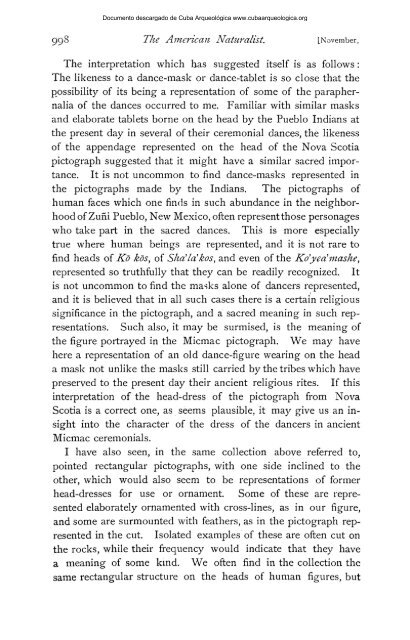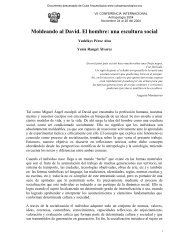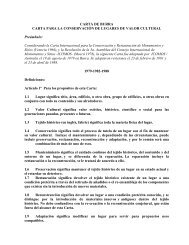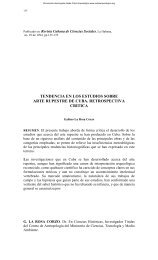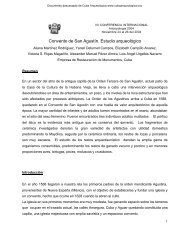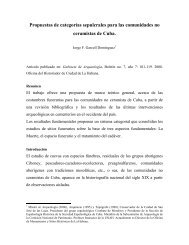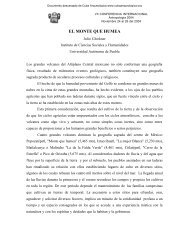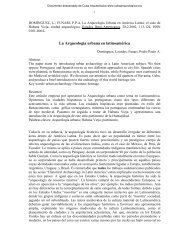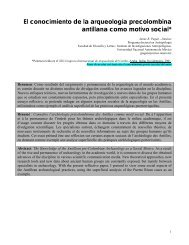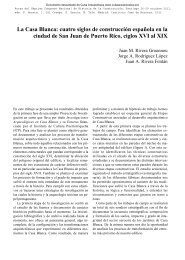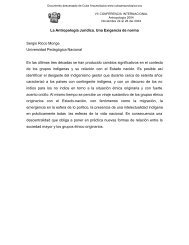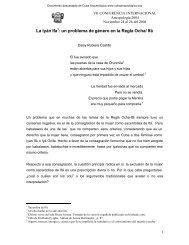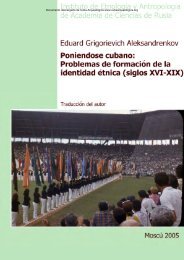A Pictograph from Nova Scotia - Cuba Arqueológica
A Pictograph from Nova Scotia - Cuba Arqueológica
A Pictograph from Nova Scotia - Cuba Arqueológica
Create successful ePaper yourself
Turn your PDF publications into a flip-book with our unique Google optimized e-Paper software.
Documento descargado de <strong>Cuba</strong> <strong>Arqueológica</strong> www.cubaarqueologica.org<br />
998 Riie American Naturalist. [November,<br />
The interpretation which has suggested itself is as follows:<br />
The likeness to a dance-mask or dance-tablet is so close that the<br />
possibility of its being a representation of some of the paraphernalia<br />
of the dances occurred to me. Familiar with similar masks<br />
and elaborate tablets borne on the head by the Pueblo Indians at<br />
the present day in several of their ceremonial dances, the likeness<br />
of the appendage represented on the head of the <strong>Nova</strong> <strong>Scotia</strong><br />
pictograph suggested that it might have a similar sacred importance.<br />
It is not uncommon to find dance-masks represented in<br />
the pictographs made by the Indians. The pictographs of<br />
human faces which one finds in such abundance in the neighborhood<br />
of Zufii Pueblo, New Mexico, often representthose personages<br />
who take part in the sacred dances. This is more especially<br />
true where human beings are represented, and it is not rare to<br />
find heads of Ko kas, of Sia'la'kos, and even of the Koyea'maske,<br />
represented so truthfully that they can be readily recognized. It<br />
is not uncommon to find the masks alone of dancers represented,<br />
and it is believed that in all such cases there is a certain religious<br />
significance in the pictograph, and a sacred meaning in such representations.<br />
Such also, it may be surmised, is the meaning of<br />
the figure portrayed in the Micmac pictograph. We may have<br />
here a representation of an old dance-figure wearing on the head<br />
a mask not unlike the masks still carried by the tribes which have<br />
preserved to the present day their ancient religious rites. If this<br />
interpretation of the head-dress of the pictograph <strong>from</strong> <strong>Nova</strong><br />
<strong>Scotia</strong> is a correct one, as seems plausible, it may give us an insight<br />
into the character of the dress of the dancers in ancient<br />
Micmac ceremonials.<br />
I have also seen, in the same collection above referred to,<br />
pointed rectangular pictographs, with one side inclined to the<br />
other, which would also seem to be representations of former<br />
head-dresses for use or ornament. Some of these are represented<br />
elaborately ornamented with cross-lines, as in our figure,<br />
and some are surmounted with feathers, as in the pictograph represented<br />
in the cut. Isolated examples of these are often cut on<br />
the rocks, while their frequency would indicate that they have<br />
a meaning of some kind. We often find in the collection the<br />
same rectangular structure on the heads of human figures, but


